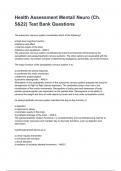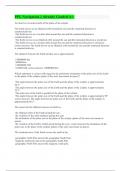Health Assessment Mental/ Neuro (Ch.
5&22) Test Bank Questions
The autonomic nervous system coordinates which of the following?
a.High-level cognitive function
b.Balance and affect
c.Internal organs of the body
d.Balance and equilibrium - ANS C
The autonomic nervous system coordinates the internal environment of the body by the
sympathetic and parasympathetic nervous systems. The other options are associated with the
cerebral cortex; its function consists of determining intelligence, personality, and motor function.
The major function of the sympathetic nervous system is to:
a.orchestrate the stress response.
b.coordinate fine motor movement.
c.determine proprioception.
d.perceive stereognosis. - ANS A
Stimulation of the sympathetic branch of the autonomic nervous system prepares the body for
emergencies for fight or flight (stress response). The cerebellum plays a key role in the
coordination of fine motor movements. Recognition of body parts and awareness of body
position (proprioception) are dependent on the parietal lobe. Stereognosis is the ability to
perceive the weight and form of solid objects by touch and is not under sympathetic control.
he parasympathetic nervous system maintains the day-to-day function of:
a.digestion.
b.response to stress.
c.lymphatic supply to the brain.
d.lymphatic drainage of the brain. - ANS A
The parasympathetic division functions in a complementary and counterbalancing manner to
conserve body resources and maintain day to day body functions, such as digestion and
elimination.
Cerebrospinal fluid serves as a:
a.nerve impulse transmitter.
b.red blood cell conveyer.
c.shock absorber.
d.mediator of voluntary skeletal movement. - ANS C
,Cerebrospinal fluid circulates between an interconnecting system of ventricles in the brain and
around the brain and spinal cord, serving as a shock absorber.
Diabetic peripheral neuropathy will likely produce:
a.hyperactive ankle reflexes.
b.diminished pain sensation.
c.exaggerated vibratory sense.
d.hypersensitive temperature perception. - ANS B
Peripheral neuropathy is a disorder of the peripheral nervous system that results in motor and
sensory loss in the distribution of one or more nerves, usually in the hands and feet. Patients
may have sensations of numbness, tingling, burning, and cramping. In moderate to severe
diabetic neuropathy, there is wasting of the foot muscles, absent ankle and knee reflexes,
decreased or no vibratory sensation below the knees, and/or loss of pain or sharp touch
sensation to the midcalf level.
The thalamus is the major integration center for the perception of:
a.speech.
b.olfaction.
c.pain.
d.thoughts. - ANS C
The thalamus is the major integrating center for the perception of various sensations such as
pain and temperature, serving as the relay center between the basal ganglia and cerebellum.
The reception of speech and interpretation of speech are located in the Wernicke area. The
olfactory sense is processed in the parietal lobe. The cerebrum holds memories, allows you to
plan, and enables you to imagine and think.
The awareness of body position is known as:
a.proprioception.
b.graphesthesia.
c.stereognosis.
d.two-point discrimination. - ANS A
Recognition of body parts and awareness of body position are known as proprioception. This is
dependent on the parietal lobe. The other options are assessment techniques that test for
sensory impairment.
Which area of the brain is responsible for perceiving sounds and determining their source?
a.Frontal lobe
b.Occipital lobe
c.Parietal lobe
d.Temporal lobe - ANS D
, The temporal lobe is responsible for the perception and interpretation of sounds and
determination of their source. The frontal lobe contains the motor cortex associated with
voluntary skeletal movement. The occipital lobe contains the primary vision center. The parietal
lobe is primarily responsible for processing received sensory data.
Peripheral nerves that arise from the brain rather than the spinal cord are called ___________
nerves.
a.sympathetic
b.parasympathetic
c.cranial
d.autonomic - ANS C
Cranial nerves are peripheral nerves that arise from the brain rather than the spinal cord. The
other choices refer to the autonomic nervous system.
Which area of the brain maintains temperature control?
a.Epithalamus
b.Thalamus
c.Abducens
d.Hypothalamus - ANS D
The hypothalamus is the major processing center of internal stimuli for the autonomic nervous
system. It maintains temperature control, water metabolism, body fluid osmolarity, feeding
behavior, and neuroendocrine activity. The epithalamus houses the pineal body and is
responsible for sexual development and behavior. The thalamus conveys all sensory impulses,
except olfaction, to and from the cerebrum before their distribution to appropriate associative
sensory areas. The abducens is the sixth cranial nerve with motor function responsible for
lateral eye movement.
If a patient cannot shrug his or her shoulders against resistance, which cranial nerve (CN)
requires further evaluation?
a.CN I, olfactory
b.CN V, trigeminal
c.CN IX, glossopharyngeal
d.CN XI, spinal accessory - ANS D
CN XI is responsible for the motor ability to shrug the shoulders. CN I is associated with smell
reception and interpretation. CN V is associated with opening of the jaw, chewing, and
sensation of the cornea, iris, conjunctiva, eyelids, forehead, nose, teeth, tongue, ear, and facial
skin. CN IX is associated with swallowing function, sensation of the nasopharynx, gag reflex,
taste, secretion of salivary glands, carotid reflex, and swallowing.
Motor maturation proceeds in an orderly progression from:





